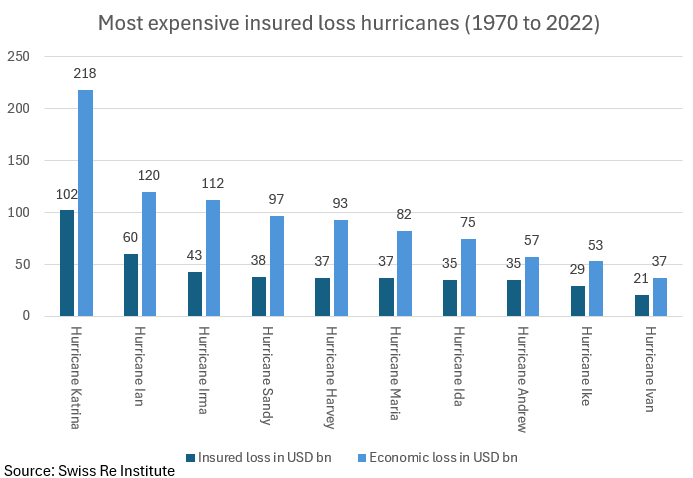Main hurricane pummeled Acapulco with shock depth

Hurricane Otis, the Class 5 storm that devastated Acapulco final 12 months, is prone to maintain extra classes for disaster modelers and insurers than every other main storm since Hurricane Andrew greater than three a long time in the past, analysts at Moody’s RMS have stated.
Otis made landfall on Mexico’s southern Pacific coast with sustained winds of 165mph final October after a speedy intensification that noticed the storm’s wind speeds improve by 115mph in lower than 24 hours, leaving greater than 1,000,000 individuals in Acapulco scrambling to organize.
The key storm, which was the primary class 5 hurricane on file to make landfall on Mexico’s West coast, drove catastrophic injury.
Financial losses from the storm are anticipated to complete $15 billion, in line with Aon, making the most important hurricane one of many costliest occasions in Mexico’s historical past.
The costliest hurricanes (ex-Otis)

Hurricane Otis drives mannequin analysis
The storm’s speedy intensification “underscores… the notion that historical past isn’t an incredible predictor for what may occur going ahead,” James Cosgrove, Moody’s RMS senior modeler, stated throughout a media briefing name on Tuesday.
With a lot left to “digest” given the comparatively current storm impression, Otis having made landfall on August 25, 2023, Moody’s RMS has been evaluating its fashions for the Pacific portion of Mexico.
“[Given the] class 5 landfall in a really densely populated space, a contemporary metropolis with fashionable excessive rises, I don’t suppose we’ve ever seen that type of a possibility to study and to collect a lot helpful data, most likely since Hurricane Andrew in 1992,” stated Jeff Waters, Moody’s RMS employees product supervisor, mannequin administration. “That is going to offer us quite a lot of alternative to study and to develop and to assist innovate our CAT fashions along with educating the broader market when it comes to resilience and having a possibility to construct again higher.”
Intense Otis drives development, codes, safety hole questions
Building high quality has proved a key takeaway for modelers up to now, with buildings having been designed to resist earthquakes however not main hurricanes.
Sometimes, buildings in Acapulco had been constructed to resist wind speeds of between 90mph to 120mph, in line with Moody’s RMS, and proved little match for Otis’ damaging depth.
With a lot take up of insurance coverage within the area focused on coastal areas and motels, there are questions over whether or not the occasion might spur demand for canopy and act as “catalyst” for closing the safety hole, Waters stated.
Why Hurricane Andrew drove CAT mannequin take up
Related questions had been raised within the aftermath of Andrew, which tore by means of the Bahamas, Louisiana, and Florida in 1992 and has been credited with driving insurance coverage business adoption of CAT fashions.
Like Otis, Andrew underwent a speedy intensification earlier than slamming into Southern Florida, rendering round 250,000 individuals briefly homeless, in line with NHC figures.
Andrew’s financial value was greater than $26 billion in Florida alone, with the state’s insured losses totaling $15.5 billion, in line with figures from Swiss Re.
Within the years that adopted, Florida enacted new constructing codes, with the state-wide Florida Constructing Code (FBC) applied in 2002 encompassing high-velocity hurricane zones in Miami-Dade and Broward County.
Acquired a view on disaster modeling within the wake of Hurricane Otis? Go away a remark under.
Associated Tales
Sustain with the most recent information and occasions
Be part of our mailing listing, it’s free!
